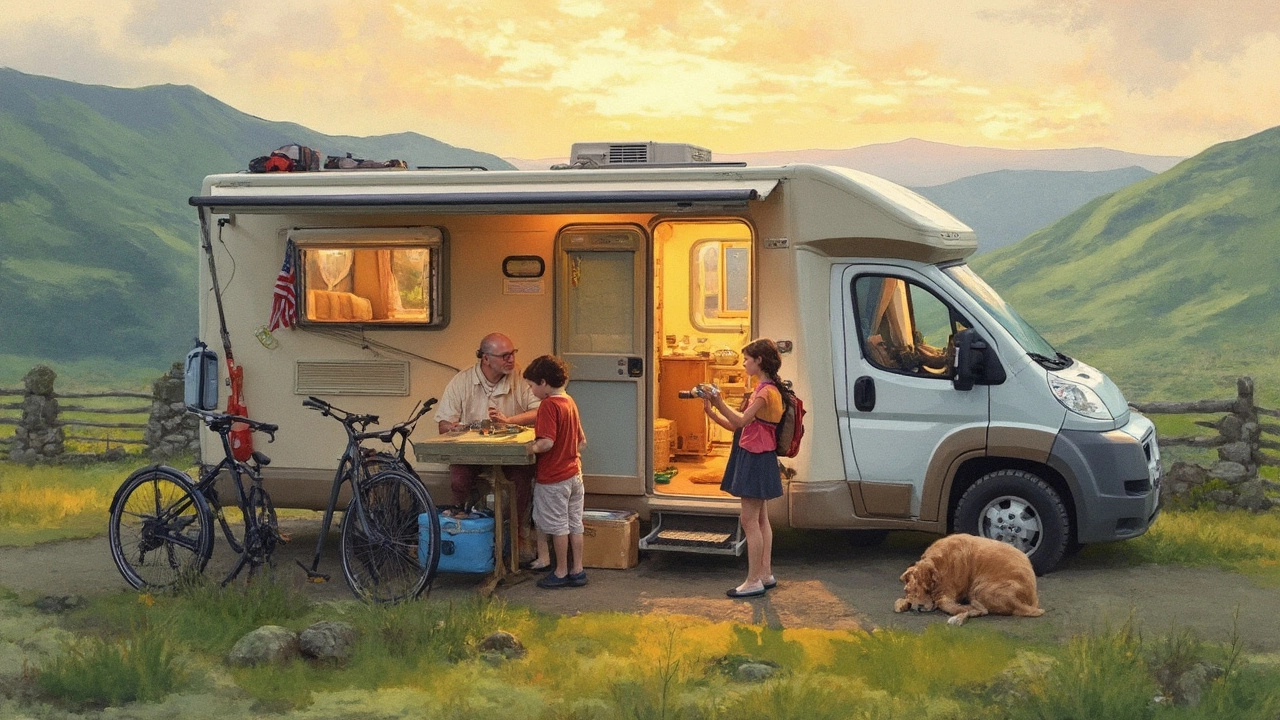Can a Person Live in an RV Full Time? Pros, Reality, and Tips
 May, 18 2025
May, 18 2025
Ever wondered if you could swap the walls of your house for the ever-changing view from an RV window? It’s not just an Instagram trend—tons of people are actually living in their motorhomes full time. But before you quit your lease and start Googling the cheapest camper, it’s smart to know what you’re signing up for.
First thing—you don’t need to be a retired millionaire to do this. I’ve met young families, solo travelers, and even people working regular remote jobs who moved into their motorhome year-round. You just have to know what daily life looks like and if it fits your vibe. Think about stuff like: Where do you shower? What about mail, internet, and getting your favorite groceries? There are workarounds for almost everything, but it takes a bit more planning and flexibility than a regular apartment.
Many folks try out RV life by hiring a motorhome for a month or a season. This gives you a real taste of space, storage (trust me, you have way less!), and daily routines like laundry on the road. If you love it, you can commit. If you don’t, you haven’t sold the house and burned all your bridges. Being realistic about your comfort levels and needs is key.
- What Full-Time RV Living Really Means
- Daily Life in an RV: The Good, the Bad, and the Weird
- Money Matters: Costs and Budgeting
- Must-Know Legal and Practical Stuff
- Tips for Making Full-Time RV Life Sustainable
What Full-Time RV Living Really Means
Living in an RV full time is exactly what it sounds like—you move into a motorhome and make it your base, not just for trips but for every day of your life. Forget occasional camping; you pack up your real-life stuff, set up utilities on the move, and swap rent or a mortgage for campgrounds or parking spots. Some people do this solo, while others go all-in as families (pets included—I’m looking at you, Rusty).
The RV living crew is actually bigger than you might think. As of 2024, estimates showed over one million Americans living in their motorhome or camper full time. That includes snowbirds who chase the warm weather, remote workers, retirees, and people just wanting to cut expenses and see new places. It’s not just an old person thing—there’s a big rise in remote workers in their 20s and 30s choosing this lifestyle.
The big draw? Freedom and flexibility. No yard work, no fixed address, and you get to wake up somewhere different as often as you want. But, your world gets much smaller physically. Your whole life squeezes into a few hundred square feet. Storage becomes a puzzle, and you have to rethink what you really need.
Daily stuff works differently. Here’s a taste of what changes:
- Utilities: Electric hookups and water refills become part of your routine. Many RVers try to stay at campgrounds with hookups, but some go "off-grid" (called boondocking). This requires solar panels or generators and managing your own water supply.
- Address: You’ll probably need a mail forwarding service for bills, packages, and legal stuff. Some RVers use a relative’s address; others sign up for services designed for nomads.
- Community: You aren’t totally alone out there. Lots of campgrounds have a sense of community, with events, bulletin boards, and people willing to lend a hand. There are also online forums and social groups just for RVers.
- Work: Many full-time RVers work remotely, do temp gigs in places they park (like national parks), or work-camp in exchange for a campsite.
RV living can look very different depending on your setup. Some folks invest in giant Class A motorhomes with all the bells and whistles, while others keep it simple with a campervan. Here’s a glance at how the basics stack up for space:
| Type | Average Size (ft²) | # of People It Fits |
|---|---|---|
| Class A Motorhome | 200–400 | 2–6 |
| Travel Trailer | 120–350 | 2–6 |
| Campervan | 70–120 | 1–2 |
So, when you see those dreamy photos online, remember—full-time RV life is a real lifestyle swap. It’s part adventure, part daily hustle, and it’s a growing way for all sorts of people to redefine “home.”
Daily Life in an RV: The Good, the Bad, and the Weird
Living in an RV full time sounds exciting, but what actually happens day-to-day? Here’s how life shifts when your address is on wheels.
If you love scenery, you win big. Your backyard constantly changes—mountains one week, the beach the next. Spontaneity is a huge perk. Rusty, my dog, gets new places to sniff and I get bored way less often than when I lived in a regular house.
Simplicity is baked in. Most RVs have about 200-400 square feet of space, so you become a ninja at organizing and only keeping what you need. Chores are faster—less floor to vacuum, barely any yard work. Want to avoid the neighbor’s noisy party? You literally drive away.
But now for the weird and the annoying. Tiny space means you and anyone you travel with need to get along—or be really good at silent treatments. Things break more often than you’d expect. RVs shake around on the road and even the best models can have leaky taps or rattling doors.
Day-to-day tasks that seem easy in a house become quests on the road. Laundry? Some RV parks have washers, but it’s not everywhere. Water tanks only hold so much—watch how many showers you take. Groceries need more planning, since your fridge is half the size of a normal one.
Mail and packages get tricky. Most full-timers use mail forwarding services or ask friends and family to help out. For internet, a lot of folks use mobile hotspots or try to snag campsites with strong Wi-Fi, but it's hit or miss in remote spots.
- Showers: Short and sweet, or you risk running out of water and filling up your grey tank fast.
- Toilets: Most RVs use cassette or black tanks, and emptying them is as fun as it sounds—but you get used to it.
- Cooking: Smaller kitchens mean simpler meals and more picnics outside.
- Storage: You get creative with shelves, baskets, and hooks. Every item has to earn its keep.
| Challenge | Workaround |
|---|---|
| Running low on water | Fill up frequently, use water-saving showerheads |
| Spotty internet | Have back-up providers, download ahead of time |
| Limited laundry | Plan stops at laundromats or RV parks with facilities |
| Small fridge space | Shop more often, use coolers for overflow |
The weirdest bit might be how quickly you start loving the small stuff—like how settling in at a campsite feels like a mini victory every time. And even though full-time RV living has its headaches, for a lot of people, the good outweighs the weird.

Money Matters: Costs and Budgeting
Let’s break down the real costs behind RV living full time, because just owning a motorhome is only half the story. Compared to a standard apartment or house, your expenses will mix up a bit: more gas, less rent, and some surprises that can sneak up on you. A big myth out there is that living in an RV is always cheaper. Sometimes it is, but not always—so let’s check out the facts.
The main expenses look like this:
- RV or Motorhome Payment: If you’re buying, new RV prices easily hit $70,000 for mid-range models. Used can start under $20,000. If you rent, it’s usually $70–$150 per day for longer hires, sometimes less for older models.
- Campsite Fees: Campgrounds average $30–$60 a night in the U.S. Some fancy resorts charge $100+. Seniors or folks on a budget often mix cheaper state parks or free spots (called boondocking) and paid sites.
- Fuel: RVs are thirsty. Average fuel economy is around 7–12 miles per gallon. If you drive 1,000 miles and gas is $4 a gallon, that’s $333–$570.
- Maintenance: Expect yearly costs of $1,000–$3,000 for repairs, oil changes, tires, and breakdowns. Stuff breaks—fridge, water pump, a/c unit… it happens.
- Internet & Cell Plans: Working or streaming on the road? Mobile hotspot plans and signal boosters can easily run you $60–$120/month.
- Insurance: Full-time RV insurance is higher than weekenders pay. Ballpark $1,000–$2,000 per year.
- Other Stuff: Propane, groceries (smaller fridge = more shopping trips), laundry, and sometimes, storage for the stuff you didn’t sell or donate.
Here’s a ballpark breakdown for one month, just to give you a clearer picture:
| Expense | Monthly Range (USD) |
|---|---|
| RV Loan or Rental | $500–$2,000 |
| Campsites | $600–$1,200 |
| Fuel | $300–$800 |
| Maintenance | $80–$250 |
| Insurance | $85–$170 |
| Internet/Phone | $60–$120 |
| Groceries/Propane | $300–$600 |
| Total | $1,925–$5,140 |
Want to save money? Lots of full-timers use rewards programs (like campground memberships), stick to slower travel, and mix in free camping. If you can work remotely, it’s even easier to stick to a routine and not overspend. Either way, grab a spreadsheet or budgeting app before you start so you know exactly where your money’s going each month. It pays to be realistic rather than rushed—nobody likes a surprise bill when they’re miles from home.
Must-Know Legal and Practical Stuff
If you’re thinking about making RV living a full-time gig, don’t just focus on the fun. There’s a list of legal and practical stuff you absolutely have to get straight before you park anywhere long term. Missing a simple step can land you with a giant headache or even a ticket.
Let’s start with the basics: addresses. Even if you don’t have one fixed location, you’ll still need a legal mailing address for your driver’s license, insurance, taxes, and voting. A lot of folks use mail forwarding services based in RV-friendly states like South Dakota, Texas, or Florida. These states make it easier to establish residency for full-time RVers, and that’s no accident—they want your business.
Parks and overnight stays have their own rules. You can’t just park anywhere and call it home. National parks, for example, usually have a 14-day stay limit. Some Walmart lots welcome overnight stays, but not every one does—always check with the store manager before popping the top on your camper. And don’t forget about local ordinances; some towns ban overnight RV parking in city limits entirely.
Vehicle insurance shifts a bit once your RV is your main address. Specialized full-time RV insurance is a must since regular recreational policies won’t cut it. Homeowner’s-style coverage can pay out for personal belongings, damage, or even temporary housing if your rig needs repairs. Costs can run from $1,500 to $4,000 per year depending on your state and coverage.
Let’s be real, staying connected is huge—work, school, or just streaming your favorite show. You can boost your mobile internet with cell boosters or dedicated mobile hotspots. Signal varies wildly out there. Check coverage maps before you settle into a remote spot if you need reliable Wi-Fi.
The logistics side matters, too. Waste management and utilities are big parts of RV living. You’re responsible for dumping wastewater (gray and black tanks) at approved dump stations or campgrounds. Many gas stations and travel plazas have them, but there’s often a small fee. And don’t dump illegally—fines are steep and the stink lingers forever. Propane and freshwater refills are also a part of the routine; keep an eye out for refill stations along regular travel routes.
If you’ve got pets, like my dog Rusty, know that not every park or RV spot is pet-friendly. Some have breed or size restrictions, and you might need updated vaccine records. Always double-check before you book a spot.
| Item | Details |
|---|---|
| Residency State Options | South Dakota, Texas, Florida most popular for full-timers |
| Mail Forwarding Service Annual Cost | ~$100-200 per year |
| Typical Insurance Range | $1,500-$4,000 per year |
| Stay Limits in National Parks | 14 days per site per month |
| Legal Dumping Stations | Located at campgrounds, truck stops, some city parks |
Checklists matter. Here’s a fast one for legal and practical prep:
- Set up legal residency and a reliable mail address.
- Select and buy full-time RV insurance, not just a basic policy.
- Learn the parking, overnight, and stay rules for every location.
- Map out service stops for dumping, propane, and fresh water.
- Make sure your internet plan supports your work or streaming needs.
- Double-check pet restrictions and required paperwork ahead of time.
Once you lock all this down, you’ve covered the basics and can actually relax and enjoy the ride.

Tips for Making Full-Time RV Life Sustainable
Making RV living work long term takes more than just wanderlust and some cool travel photos. Long haulers know it’s all about routine, planning, and a few smart hacks.
First, figure out your budget and stick to it. Costs can sneak up—fuel, campground fees, maintenance, and the occasional surprise (like that tire blowout I had outside Amarillo). Here’s a look at what people actually spend each month:
| Expense | Low End ($/mo) | High End ($/mo) |
|---|---|---|
| Campgrounds | 300 | 1,200 |
| Fuel | 150 | 600 |
| Maintenance | 50 | 300 |
| Groceries | 300 | 700 |
| Internet/Phone | 60 | 150 |
If you want to live cheap, mix in free spots like national forests (called “boondocking”). Use apps such as Campendium and iOverlander to find these places. Solar panels and good batteries let you stay self-sufficient and skip pricey hookups.
Next up, organization is your best friend. Everything needs a spot, or you end up with chaos and no room for the dog. Use under-bed bins, magnetic spice racks, and collapsible gear. Give away or store anything you don’t use weekly.
Staying connected is easier than it used to be—mobile hotspots, Starlink, and campground Wi-Fi mean you can work, stream, or call home from most places now. Always test your internet before planning a big workday if you’re still on the clock.
Don’t ignore maintenance. Create a monthly checklist: check tires, water systems, seals, and clean filters. A tiny leak or busted heater can get ugly if you ignore it. Spare parts like hoses and fuses go a long way when you’re miles from the next store.
Finally, build a routine and get social. It’s easy to feel isolated, especially if you’re not traveling with friends or family. RV groups, rallies, and online forums are a goldmine for advice and connection. Even Rusty, my dog, made more friends last month than I did at my old office.
- Always have a backup plan for weather, emergencies, or campground closures.
- Use mail forwarding services so you never miss important stuff.
- Set aside a bit of “mad money” for those curveballs—tow trucks aren’t cheap.
Sustainability isn’t just recycling—it’s making sure you love the lifestyle, not just survive it. The smart prep keeps full-time RV life from turning into full-time headaches.